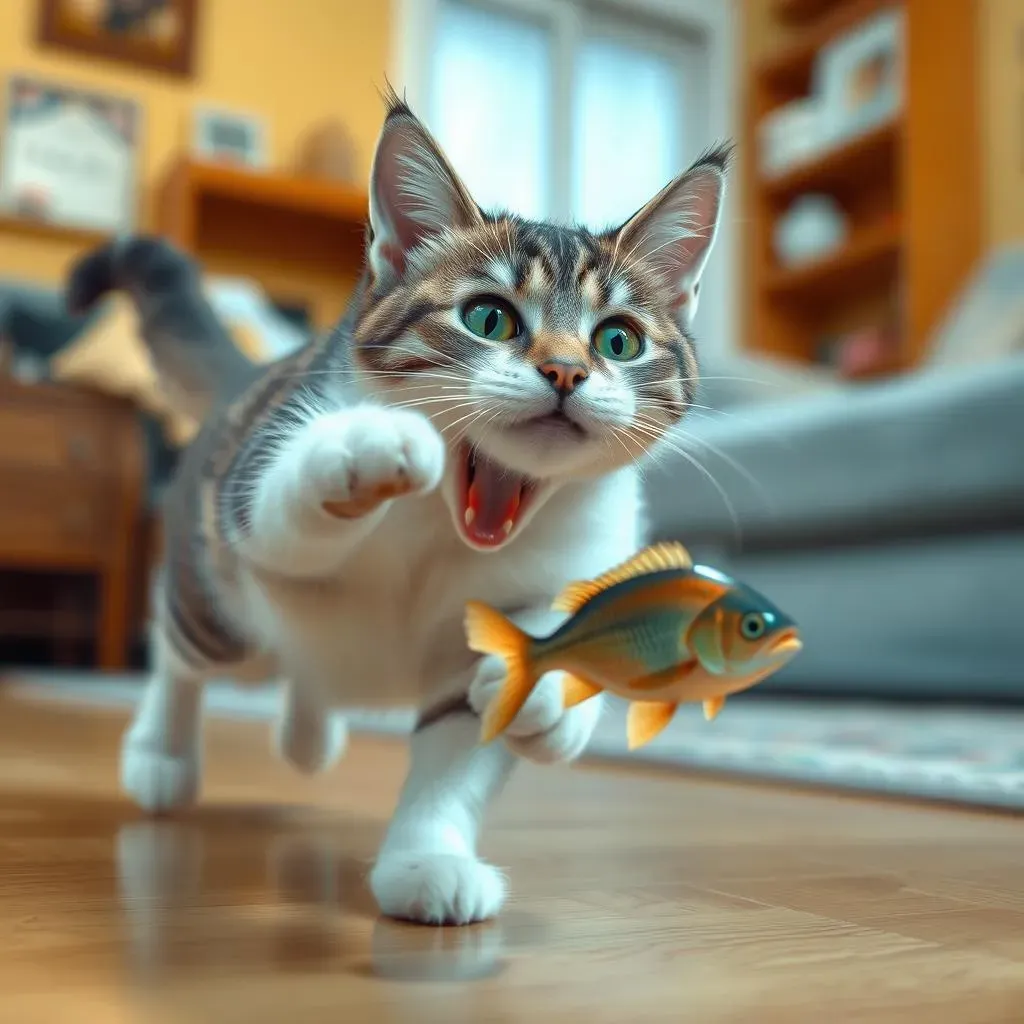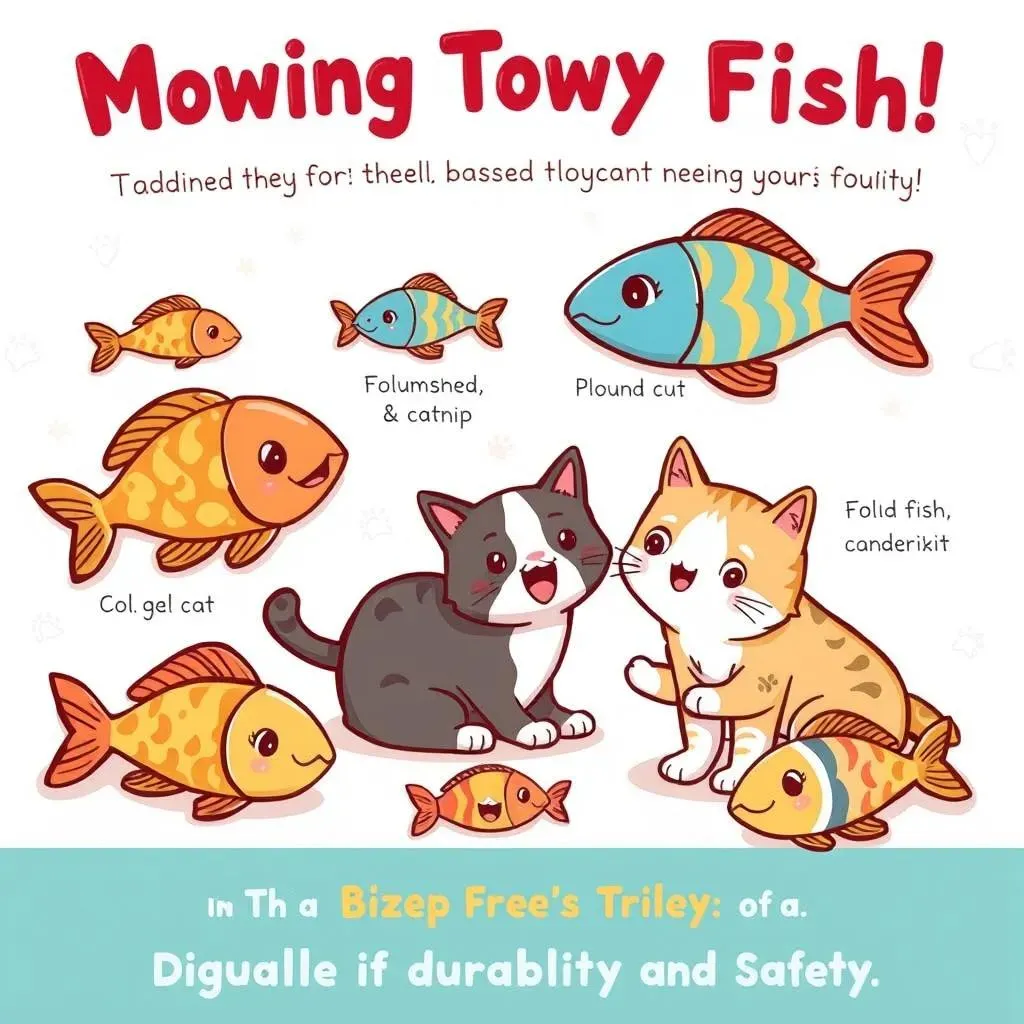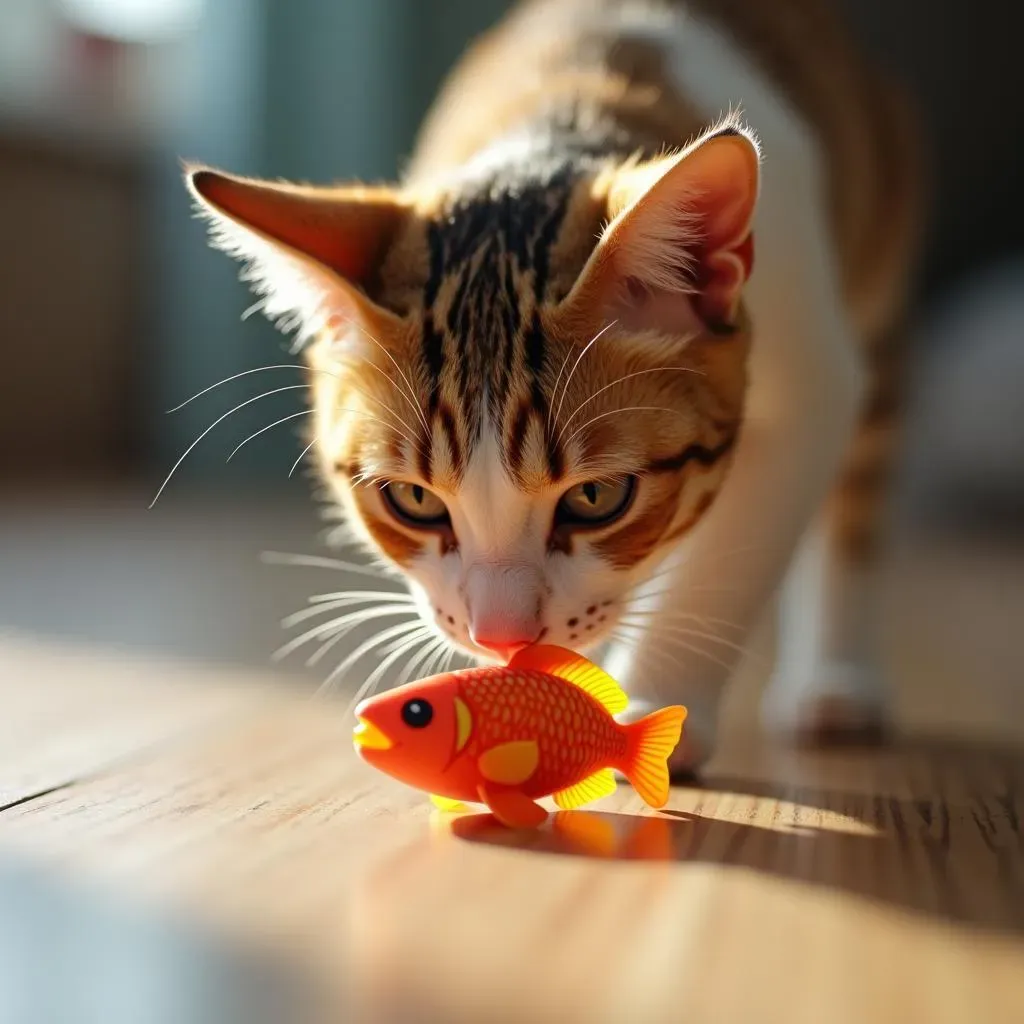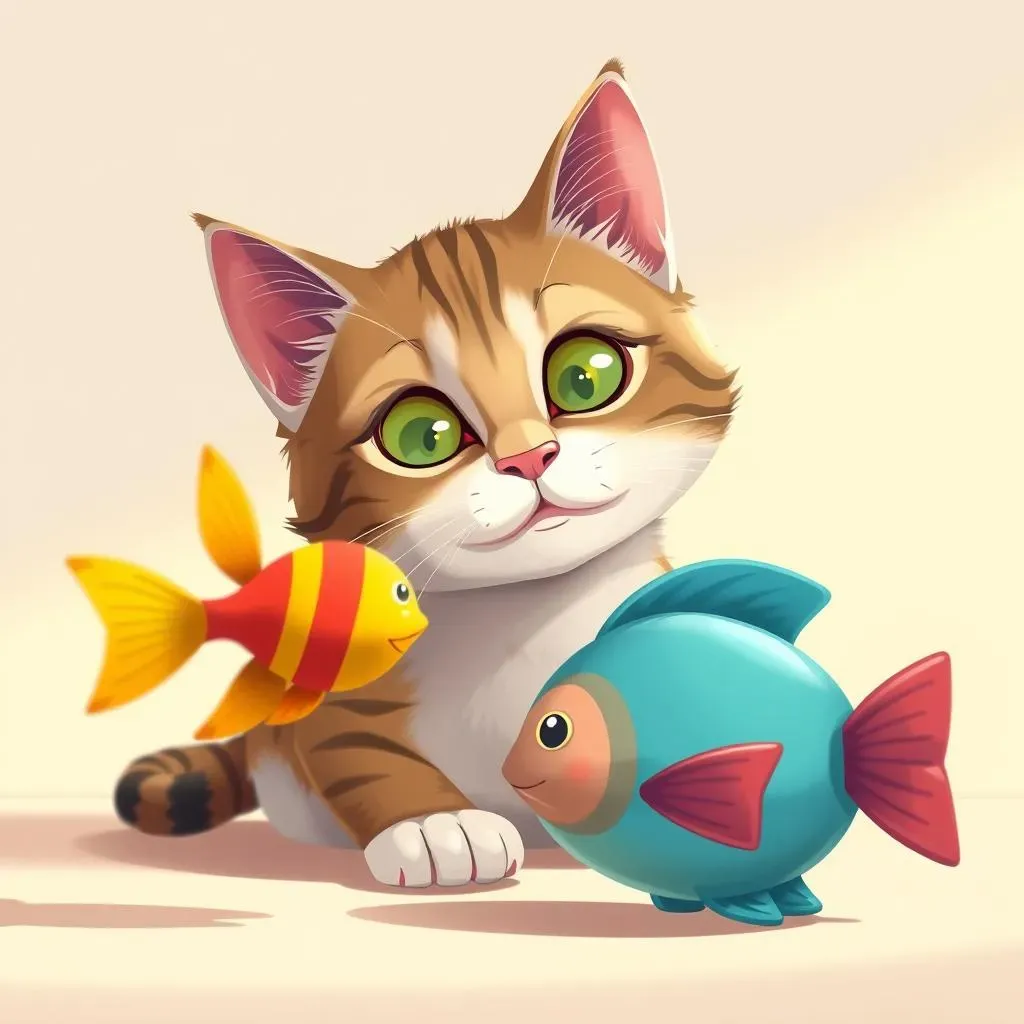Table of Contents
Ever watched your cat stalk a dust bunny like it's the most thrilling hunt of their life? Now, imagine that same focus, but with a toy that actually moves! That's the magic of a moving toy fish for cats. These aren't your grandma's yarn balls. We're talking about robotic, flopping, sometimes even chirping, fish designed to tap into your cat's inner predator. It's like bringing the Discovery Channel right into your living room, only way more interactive and less David Attenborough. This article will take you through the basics of why these toys are so captivating, how to pick the perfect one, and tricks to make sure your cat actually plays with it. Plus, we'll go over some common issues and how to fix them, because let's face it, even the coolest toys can have their off days. Ready to turn your couch potato into a leaping, pouncing panther? Let's get started!
Why Your Cat Needs a Moving Toy Fish

Why Your Cat Needs a Moving Toy Fish
Unleashing the Inner Hunter
Let's face it, our domesticated cats still have that wild streak. They're born to hunt, even if their "prey" is a fuzzy mouse toy or your unsuspecting toes under the blanket. A moving toy fish taps directly into this instinct. It's not just a random object; the realistic wiggle and flop trigger their predatory drive, making them feel like they're actually on a hunt. Think of it like a video game for cats, where the prize is the thrill of the chase. It's way more engaging than a static toy and helps keep their minds sharp.
A bored cat can quickly become a destructive cat. They might start scratching furniture, getting into things they shouldn't, or even becoming lethargic. A moving fish provides an outlet for their energy, keeping them active and entertained. It's not just about burning calories; it's about fulfilling their natural behaviors. When they get to stalk, pounce, and "catch" their fish, they're less likely to turn your curtains into a climbing wall or your socks into chew toys.
Benefits of a Moving Toy Fish
- Mental Stimulation: Keeps your cat's mind engaged and sharp.
- Physical Exercise: Encourages activity and helps prevent obesity.
- Reduced Boredom: Provides an outlet for energy and natural instincts.
- Less Destructive Behavior: A happy, engaged cat is less likely to misbehave.
Choosing the Best Moving Toy Fish for Your Cat

Choosing the Best Moving Toy Fish for Your Cat
Size Matters
Okay, so you're ready to get your cat a new fish friend, but hold on a second, not all fish are created equal. You wouldn't buy a Great Dane a chihuahua-sized bed, right? Same logic applies here. Think about your cat's size and play style. A tiny kitten might be overwhelmed by a huge, flopping fish, while a larger cat might find a small one boring. It's about finding that Goldilocks zone of 'just right'. If your cat likes to wrestle, a bigger, sturdier fish is better. If they prefer batting, a smaller, lighter one will do the trick.
Also consider the space you have available. A giant fish might not be the best if you live in a tiny apartment. You want to make sure your cat has room to move around and 'hunt' without knocking over your favorite lamp. It is also important to think about the material of the toy. Is it soft enough for your cat to bite? Is it durable enough to withstand some serious play? These are all important considerations.
Features to Consider
Now, let's talk about the bells and whistles. Or should I say, the wiggles and flops? Some moving fish are pretty basic, just a simple vibrating motion, while others have all sorts of fancy features. There are fish that flop realistically, some that make sounds, and even some that have catnip inside. It's like choosing a car, do you want the basic model or the one with all the upgrades? A realistic flopping motion can be highly attractive to cats, as it mimics the movement of real prey. Sound can also be a great addition, but make sure it's not too loud or annoying. You don't want to drive yourself crazy while your cat is having fun. Catnip is a classic, but not every cat loves it, so consider your cat's preferences.
Also, think about the battery life and charging method. Some use regular batteries, while others are rechargeable via USB. Rechargeable ones are more convenient and eco-friendly in the long run, but make sure the charging port is durable. You don't want it breaking after a few charges. Some fish have replaceable parts, like the motor or the covering, and those are worth considering if you want the toy to last.
Feature | Description | Why it Matters |
|---|---|---|
Flopping Motion | Realistic side-to-side movement | Engages hunting instincts |
Sound | Chirping or other noises | Adds to the realism |
Catnip | Infused or insertable catnip | Attracts and excites cats |
Durability | Strong materials and construction | Ensures long-lasting play |
Charging | Battery or USB rechargeable | Convenience and cost |
Safety First
Before you click 'buy now,' let's talk safety. You want your cat to have fun, but you also want them to be safe. Make sure the fish is made of non-toxic materials. Cats love to bite and chew, so you want to avoid anything that could be harmful if ingested. Also, check for small parts that could come off and be a choking hazard. If your cat is a real chewer, keep an eye on the toy and replace it if it shows signs of damage.
The best way to ensure you are buying a safe toy is to read reviews from other pet owners, these reviews can give you a good idea of how durable the toy is and any potential issues with it. Also, consider the size of the toy again, make sure it is not small enough for your cat to swallow. You want to be a responsible pet owner, so buying safe toys is essential.
How to Introduce a Moving Toy Fish to Your Cat

How to Introduce a Moving Toy Fish to Your Cat
The Gentle Approach
Alright, you've got the perfect moving toy fish for cats, now what? Don't just throw it at your cat and expect them to go wild. Think of it like introducing a new friend; you want to be gentle and let them get acquainted at their own pace. Start by letting your cat sniff the fish while it's turned off. Let them explore it with their paws, rub their face on it, whatever they need to do to get comfortable. This is all about building trust and curiosity, not forcing interaction. If they seem scared or uninterested, don't push it. Just put the fish away and try again later. Patience is key here, my friend.
Once your cat seems comfortable with the fish in its static state, try turning it on for brief periods. Don't go for full-on flopping frenzy right away. Start with short bursts of movement, just a few seconds at a time. Observe your cat's reaction. Are they curious, or are they hiding under the couch? If they're curious, encourage them with some praise and maybe a treat. If they're scared, turn it off and try again later with even shorter bursts of movement. Remember, you want this to be a positive experience, not a scary one.
Playtime Tips and Tricks
Okay, so your cat is now interacting with the moving fish, that's great, but let's make sure it's actually fun! Don't just leave the fish on the floor and walk away. Participate in the play session. Drag the fish around on a string or use a wand toy to mimic the movement of real prey. This will make the fish even more enticing and engaging for your cat. You can also try hiding the fish under a blanket or pillow and then letting your cat "discover" it. This taps into their hunting instincts and makes the game more challenging.
Remember to keep playtime sessions short and frequent. Cats have short attention spans, so a few 5-10 minute sessions a day are better than one long one. Also, be sure to mix it up. Don't always play in the same way or in the same location. This will keep your cat engaged and prevent boredom. And most importantly, always end the play session on a positive note. Let your cat "catch" the fish and give them some praise and a treat. This will help them associate the toy with positive experiences.
Tip | Description |
|---|---|
Start Slow | Introduce the fish gradually, letting your cat sniff and explore it while it's off. |
Short Bursts | Begin with short periods of movement, increasing the duration as your cat becomes more comfortable. |
Interactive Play | Participate in the play session, using a wand or string to mimic prey movement. |
Vary Playtime | Keep play sessions short and frequent, mixing up the location and style. |
Positive Ending | Always end the play session with a "catch" and some praise or treat. |
Troubleshooting Common Issues with Moving Toy Fish for Cats

Troubleshooting Common Issues with Moving Toy Fish for Cats
My Cat Ignores the Fish
Okay, so you’ve got this awesome, flopping fish, and your cat is acting like it's invisible? Don't panic, it happens. Sometimes, cats just aren't immediately impressed. First, make sure the fish is actually working. Is it moving properly? Is the sound working, if it has one? If everything seems fine, try a different approach. Maybe your cat isn't a fan of the way it moves or the sound it makes. Some cats prefer a slower, more subtle movement, while others are attracted to more dramatic action. Try different play styles; use a wand or string to make it more engaging, or add a sprinkle of catnip to see if that piques their interest.
Also, consider where you’re placing the fish. A cluttered area might make it less appealing. Try moving it to a more open space where your cat can see it clearly and have room to play. If you have multiple cats, make sure they each have access to the toy without feeling like they have to compete. Sometimes, a cat might be intimidated by the other cats and not want to play in the same space. Patience is key, some cats need a bit more time to warm up to new toys. Don't give up; just keep experimenting with different approaches and play styles until you find what works.
- Check the Basics: Make sure the toy is working correctly.
- Try Different Play Styles: Use a wand, string, or catnip to make it more engaging.
- Change the Location: Move the fish to a more open space.
- Be Patient: Some cats take time to warm up to new toys.
The Fish Stopped Working
So, your cat was finally having a blast, and now the fish is just…dead. Before you throw it in the trash, let's troubleshoot. First, check the batteries. Are they dead? If it's a rechargeable fish, make sure it's fully charged. Sometimes, the charging port can get a bit wonky, so try cleaning it gently with a dry cloth or a cotton swab. If the batteries aren't the issue, there might be a problem with the motor or other internal components. Check for any obvious signs of damage. Has your cat been particularly rough with it? If you can, try opening the toy and checking the connections, but be careful not to damage it further.
If you've tried all of the above and the fish is still not working, it might be time to contact the manufacturer or the retailer. Many toys come with a warranty, so check if yours is still covered. If not, it might be time to invest in a new one. But before you do, consider the cause of the problem. Was it a manufacturing issue, or did your cat destroy it with its enthusiasm? This might help you choose a more durable toy next time. Remember, toys don't last forever, especially with a determined cat at play.
Problem | Possible Solution |
|---|---|
Dead Batteries | Replace batteries or recharge the toy. |
Faulty Charging Port | Clean the charging port gently. |
Internal Damage | Check for any obvious signs of damage and fix if possible. |
Manufacturer Issue | Contact the manufacturer for warranty or replacement. |
My Cat is Scared of the Fish
Okay, so instead of a playful pounce, your cat is giving the fish a wide berth? That's not ideal, but it's also not uncommon. Some cats are just a bit more cautious than others. Don’t force the issue. The key is to make the fish seem less threatening. Start by placing the fish in a room where your cat feels comfortable, but make sure it's turned off. Let them approach it at their own pace, and don't push them to interact with it. Once they seem comfortable with the static fish, try turning it on for very short periods, like a few seconds, and then turn it off again.
You can also try making the fish less intimidating by covering it with a thin blanket or towel. This will muffle the movements and sounds, making it seem less scary. As your cat gets more comfortable, slowly expose more of the fish. You can also try associating the fish with positive things, like treats or praise. When your cat is near the fish, give them a treat or some positive attention. If your cat is still very scared, it might be best to put the fish away and try again later. Remember, every cat is different, and some just need a little more time and patience to get used to new things.
"The best way to understand your cat is to watch them closely, their behaviors will tell you everything you need to know." - A wise cat lover
The Final Splash
So, there you have it, the lowdown on moving toy fish for cats. They're not just another fad; they're a great way to keep your feline friend active, entertained, and out of trouble (mostly). From picking the right flopping fish to troubleshooting the occasional battery hiccup, you're now equipped to make your cat's playtime a whole lot more exciting. Remember, every cat is different, so a little trial and error might be needed. But when you see that gleam in their eyes as they stalk, pounce, and bat at their new robotic prey, you'll know it was worth it. Now go on, give your cat the gift of a never-ending fish chase!